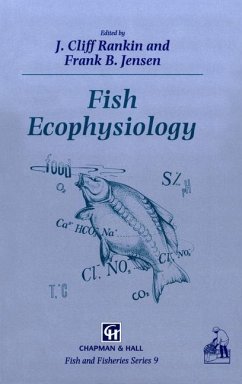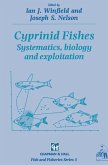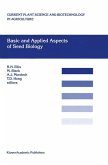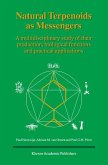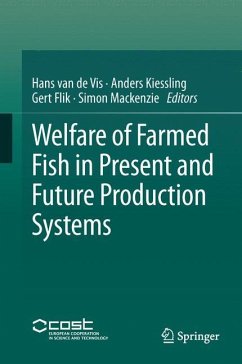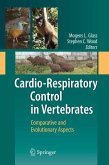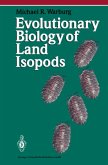- Broschiertes Buch
- Merkliste
- Auf die Merkliste
- Bewerten Bewerten
- Teilen
- Produkt teilen
- Produkterinnerung
- Produkterinnerung
Among the fishes. a remarkably wide range of biological adaptations to diverse habitats has evolved. As well as living in the conventional habitats of lakes. ponds, rivers, rock pools and the open sea, fish have solved the problems of life in deserts. in the deep sea. in the cold antarctic. and in warm waters of high alkalinity or of low oxygen. Along with these adaptations, we find the most impressive specialisations of morphology, physiology and behaviour. For example we can marvel at the high-speed swimming of the marlins. sailfish and warm-blooded tunas, air-breathing in catfish and…mehr
Andere Kunden interessierten sich auch für
![Cyprinid Fishes Cyprinid Fishes]() Cyprinid Fishes89,99 €
Cyprinid Fishes89,99 €![Basic and Applied Aspects of Seed Biology Basic and Applied Aspects of Seed Biology]() Basic and Applied Aspects of Seed Biology386,99 €
Basic and Applied Aspects of Seed Biology386,99 €![Natural Terpenoids as Messengers Natural Terpenoids as Messengers]() Paul HarrewijnNatural Terpenoids as Messengers154,99 €
Paul HarrewijnNatural Terpenoids as Messengers154,99 €![Welfare of Farmed Fish in Present and Future Production Systems Welfare of Farmed Fish in Present and Future Production Systems]() Welfare of Farmed Fish in Present and Future Production Systems117,99 €
Welfare of Farmed Fish in Present and Future Production Systems117,99 €![The Evolution of Begging The Evolution of Begging]() The Evolution of Begging154,99 €
The Evolution of Begging154,99 €![Cardio-Respiratory Control in Vertebrates Cardio-Respiratory Control in Vertebrates]() Cardio-Respiratory Control in Vertebrates154,99 €
Cardio-Respiratory Control in Vertebrates154,99 €![Evolutionary Biology of Land Isopods Evolutionary Biology of Land Isopods]() Michael R. WarburgEvolutionary Biology of Land Isopods93,99 €
Michael R. WarburgEvolutionary Biology of Land Isopods93,99 €-
-
-
Among the fishes. a remarkably wide range of biological adaptations to diverse habitats has evolved. As well as living in the conventional habitats of lakes. ponds, rivers, rock pools and the open sea, fish have solved the problems of life in deserts. in the deep sea. in the cold antarctic. and in warm waters of high alkalinity or of low oxygen. Along with these adaptations, we find the most impressive specialisations of morphology, physiology and behaviour. For example we can marvel at the high-speed swimming of the marlins. sailfish and warm-blooded tunas, air-breathing in catfish and lungfish. parental care in the mouth-brooding cichlids and viviparity in many sharks and toothcarps. Moreover, fish are of considerable importance to the survival of the human species in the form of nutritious. delicious and diverse food. Rational exploi management of our global stocks of fishes must rely upon a detailed tation and and precise insight of their biology. The Chapman [.,. Hall Fish and Fisheries series aims to present timely volumes reviewing important aspects of fish biology. Most volumes will be of interest to research workers in biology. zoology. ecology and physiology but an additional aim is for the books to be accessible to a wide spectrum of non-specialist readers ranging from undergraduates and postgraduates to those with an interest in industrial and commercial aspects of IIsh and t1sheries.
Hinweis: Dieser Artikel kann nur an eine deutsche Lieferadresse ausgeliefert werden.
Hinweis: Dieser Artikel kann nur an eine deutsche Lieferadresse ausgeliefert werden.
Produktdetails
- Produktdetails
- Fish & Fisheries Series 9
- Verlag: Springer / Springer Netherlands
- Artikelnr. des Verlages: 978-94-010-5017-3
- 1993
- Seitenzahl: 444
- Erscheinungstermin: 3. Oktober 2013
- Englisch
- Abmessung: 235mm x 155mm x 24mm
- Gewicht: 668g
- ISBN-13: 9789401050173
- ISBN-10: 9401050171
- Artikelnr.: 39491217
- Herstellerkennzeichnung Die Herstellerinformationen sind derzeit nicht verfügbar.
- Fish & Fisheries Series 9
- Verlag: Springer / Springer Netherlands
- Artikelnr. des Verlages: 978-94-010-5017-3
- 1993
- Seitenzahl: 444
- Erscheinungstermin: 3. Oktober 2013
- Englisch
- Abmessung: 235mm x 155mm x 24mm
- Gewicht: 668g
- ISBN-13: 9789401050173
- ISBN-10: 9401050171
- Artikelnr.: 39491217
- Herstellerkennzeichnung Die Herstellerinformationen sind derzeit nicht verfügbar.
1 Bioenergetics: feed intake and energy partitioning.- 1.1 Introduction.- 1.2 Basic principles.- 1.3 Factors influencing ingestion (R).- 1.4 Factors influencing faecal losses (F).- 1.5 Products of nitrogenous excretion (U).- 1.6 Factors influencing metabolism (M).- 1.7 Factors affecting growth and production (P).- 1.8 Concluding remarks.- References.- 2 Biochemical correlates of growth rate in fish.- 2.1 Introduction.- 2.2 Protein synthesis and growth.- 2.3 Perturbations in the general model.- 2.4 Protein synthesis and energy consumption.- 2.5 Free amino acids and protein turnover.- 2.6 Growth and its correlates in the tissues.- 2.7 Biochemical indices of growth rate.- 2.8 Linkage between aerobic enzymes and RNA.- 2.9 Body size effects on protein growth. synthesis and RNA concentrations.- 2.10 Temperature.- 2.11 Estimation of growth rate of fish in the North Sea.- Acknowledgements.- References.- 3 Growth, reproduction and death in lampreys and eels.- 3.1 General introduction.- 3.2 Lampreys.- 3.3 Eels.- 3.4 General discussion.- Acknowledgements.- References.- 4 Salmonid smolting: a pre-adaptation to the oceanic environment.- 4.1 Introduction.- 4.2 Changes during parr-smolt transformation.- 4.3 Role of environmental factors.- 4.4 Conclusion.- Acknowledgements.- References.- 5 Role of peptide hormones in fish osmoregulation.- 5.1 Introduction.- 5.2 Growth hormone (GH).- 5.3 Angiotensin II (ANGII).- 5.4 Arginine vasotocin (A VT).- 5.5 Urotensins (UI and UII).- 5.6 Vasoactive intestinal peptide (VIP).- 5.7 Natriuretic peptides.- Acknowledgements.- References.- 6 Environmental perturbations of oxygen transport in teleost fishes: causes, consequences and compensations.- 6.1 Introduction.- 6.2 Hypoxia.- 6.3 Combined hypoxia-hypercapnia.- 6.4 Temperature.- 6.5 Salinity change.- 6.6 Effects of toxicants.- 6.7 Concluding remarks.- Acknowledgements.- References.- 7 Cardiovascular and ventilatory control during hypoxia.- 7.1 Introduction.- 7.2 Chemoreceptors.- 7.3 Mechanoreceptors.- 7.4 Catecholamine release.- 7.5 Methods of studying ventilation in water-breathing animals.- 7.6 Ventilatory responses to hypoxia.- 7.7 Circulatory responses to hypoxia.- 7.8 General conclusions.- Acknowledgements.- References.- 8 Acid-base regulation in response to changes of the environment:characteristics and capacity.- 8.1 Introduction.- 8.2 Environmentally induced changes of the acid-base status.- 8.3 Characteristics of regulatory responses.- 8.4 Capacity of acid-base relevant ion-transfer mechanisms as a function of environmental conditions.- 8.5 Conclusion.- References.- 9 Environmental effects on fish gill structure and function.- 9.1 Introduction.- 9.2 Environmental ions.- 9.3 Morphological component to acid-base regulation.- 9.4 Environmental pH and oxygen.- Acknowledgements.- References.- 10 Effects of water pH on gas and ion transfer across fish gills.- 10.1 Introduction.- 10.2 Proton excretion.- 10.3 Effect of water pH on proton transport.- 10.4 Interactions between proton, carbon dioxide and ammonia excretion.- 10.5 Sodium uptake.- 10.6 Chloride uptake.- 10.7 Carbon dioxide transfer.- 10.8 Oxygen transfer.- 10.9 Ammonia excretion.- 10.10 Swimming performance.- References.- 11 Endocrine responses to environmental pollutants.- 11.1 Introduction.- 11.2 Adrenocortical response.- 11.3 Adrenergic responses.- 11.4 Prolactin.- 11.5 Thyroid response.- 11.6 Future studies.- References.- 12 Branchial mechanisms of acclimation to metals in freshwater fish.- 12.1 Introduction.- 12.2 Effects of metals on gill morphology.- 12.3 'Shock' phase.- 12.4 Branchial defences against acute metal toxicity.- 12.5 Recovery and the origin of metal tolerance.- 12.6 Increased tolerance via decreased metal accumulation by the gills.- 12.7 Increased tolerance via increased metal storage and detoxification in gill tissue.- 12.8 Increased tolerance via increased resistance of metal-sensitive processes.- 12.9 Conclusions.- 12.10 Future research directions.- Acknowledgements.- References.- 13 Phenotypic plasticity of fish muscle to temperature change.- 13.1 Introduction.- 13.2 Muscle function and temperature.- 13.3 Temperature acclimation of swimming performance.- 13.4 Plasticity of muscle phenotypes.- 13.5 Muscle contractile properties.- 13.6 Muscle metabolism.- 13.7 Future prospects.- Acknowledgement.- References.- 14 Recent advances in the ecophysiology of Antarctic notothenioid fishes: metabolic capacity and sensory performance.- 14.1 Introduction.- 14.2 Respiration and metabolism.- 14.3 The cardiovascular system.- 14.4 The blood oxygen transport system.- 14.5 Responses to stress.- 14.6 Sensory ecophysiology of notothenioid fishes.- 14.7 Ecophysiology and evolution of notothenioid fishes.- Acknowledgements.- References.- 15 Ecophysiology of intertidal fish.- 15.1 Introduction.- 15.2 The intertidal environment.- 15.3 Temperature.- 15.4 Osmoregulation.- 15.5 Respiratory adaptations.- Acknowledgements.- References.- Author index.
1 Bioenergetics: feed intake and energy partitioning.- 1.1 Introduction.- 1.2 Basic principles.- 1.3 Factors influencing ingestion (R).- 1.4 Factors influencing faecal losses (F).- 1.5 Products of nitrogenous excretion (U).- 1.6 Factors influencing metabolism (M).- 1.7 Factors affecting growth and production (P).- 1.8 Concluding remarks.- References.- 2 Biochemical correlates of growth rate in fish.- 2.1 Introduction.- 2.2 Protein synthesis and growth.- 2.3 Perturbations in the general model.- 2.4 Protein synthesis and energy consumption.- 2.5 Free amino acids and protein turnover.- 2.6 Growth and its correlates in the tissues.- 2.7 Biochemical indices of growth rate.- 2.8 Linkage between aerobic enzymes and RNA.- 2.9 Body size effects on protein growth. synthesis and RNA concentrations.- 2.10 Temperature.- 2.11 Estimation of growth rate of fish in the North Sea.- Acknowledgements.- References.- 3 Growth, reproduction and death in lampreys and eels.- 3.1 General introduction.- 3.2 Lampreys.- 3.3 Eels.- 3.4 General discussion.- Acknowledgements.- References.- 4 Salmonid smolting: a pre-adaptation to the oceanic environment.- 4.1 Introduction.- 4.2 Changes during parr-smolt transformation.- 4.3 Role of environmental factors.- 4.4 Conclusion.- Acknowledgements.- References.- 5 Role of peptide hormones in fish osmoregulation.- 5.1 Introduction.- 5.2 Growth hormone (GH).- 5.3 Angiotensin II (ANGII).- 5.4 Arginine vasotocin (A VT).- 5.5 Urotensins (UI and UII).- 5.6 Vasoactive intestinal peptide (VIP).- 5.7 Natriuretic peptides.- Acknowledgements.- References.- 6 Environmental perturbations of oxygen transport in teleost fishes: causes, consequences and compensations.- 6.1 Introduction.- 6.2 Hypoxia.- 6.3 Combined hypoxia-hypercapnia.- 6.4 Temperature.- 6.5 Salinity change.- 6.6 Effects of toxicants.- 6.7 Concluding remarks.- Acknowledgements.- References.- 7 Cardiovascular and ventilatory control during hypoxia.- 7.1 Introduction.- 7.2 Chemoreceptors.- 7.3 Mechanoreceptors.- 7.4 Catecholamine release.- 7.5 Methods of studying ventilation in water-breathing animals.- 7.6 Ventilatory responses to hypoxia.- 7.7 Circulatory responses to hypoxia.- 7.8 General conclusions.- Acknowledgements.- References.- 8 Acid-base regulation in response to changes of the environment:characteristics and capacity.- 8.1 Introduction.- 8.2 Environmentally induced changes of the acid-base status.- 8.3 Characteristics of regulatory responses.- 8.4 Capacity of acid-base relevant ion-transfer mechanisms as a function of environmental conditions.- 8.5 Conclusion.- References.- 9 Environmental effects on fish gill structure and function.- 9.1 Introduction.- 9.2 Environmental ions.- 9.3 Morphological component to acid-base regulation.- 9.4 Environmental pH and oxygen.- Acknowledgements.- References.- 10 Effects of water pH on gas and ion transfer across fish gills.- 10.1 Introduction.- 10.2 Proton excretion.- 10.3 Effect of water pH on proton transport.- 10.4 Interactions between proton, carbon dioxide and ammonia excretion.- 10.5 Sodium uptake.- 10.6 Chloride uptake.- 10.7 Carbon dioxide transfer.- 10.8 Oxygen transfer.- 10.9 Ammonia excretion.- 10.10 Swimming performance.- References.- 11 Endocrine responses to environmental pollutants.- 11.1 Introduction.- 11.2 Adrenocortical response.- 11.3 Adrenergic responses.- 11.4 Prolactin.- 11.5 Thyroid response.- 11.6 Future studies.- References.- 12 Branchial mechanisms of acclimation to metals in freshwater fish.- 12.1 Introduction.- 12.2 Effects of metals on gill morphology.- 12.3 'Shock' phase.- 12.4 Branchial defences against acute metal toxicity.- 12.5 Recovery and the origin of metal tolerance.- 12.6 Increased tolerance via decreased metal accumulation by the gills.- 12.7 Increased tolerance via increased metal storage and detoxification in gill tissue.- 12.8 Increased tolerance via increased resistance of metal-sensitive processes.- 12.9 Conclusions.- 12.10 Future research directions.- Acknowledgements.- References.- 13 Phenotypic plasticity of fish muscle to temperature change.- 13.1 Introduction.- 13.2 Muscle function and temperature.- 13.3 Temperature acclimation of swimming performance.- 13.4 Plasticity of muscle phenotypes.- 13.5 Muscle contractile properties.- 13.6 Muscle metabolism.- 13.7 Future prospects.- Acknowledgement.- References.- 14 Recent advances in the ecophysiology of Antarctic notothenioid fishes: metabolic capacity and sensory performance.- 14.1 Introduction.- 14.2 Respiration and metabolism.- 14.3 The cardiovascular system.- 14.4 The blood oxygen transport system.- 14.5 Responses to stress.- 14.6 Sensory ecophysiology of notothenioid fishes.- 14.7 Ecophysiology and evolution of notothenioid fishes.- Acknowledgements.- References.- 15 Ecophysiology of intertidal fish.- 15.1 Introduction.- 15.2 The intertidal environment.- 15.3 Temperature.- 15.4 Osmoregulation.- 15.5 Respiratory adaptations.- Acknowledgements.- References.- Author index.

